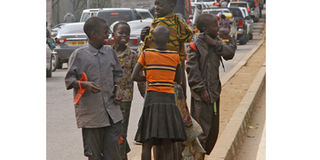Why are institutions failing to end violence against children?

Begging. Street children wander on the streets of Kampala last Month. Many children have abandoned their homes due to violence to beg on streets. PHOTO BY ABUBAKER LUBOWA
What you need to know:
Child protection: In Uganda, a number of institutions are involved in fighting violence against children. Esther Oluka explores some of the efforts they have made towards ending the vice, and also addresses the challenges they continuously face in this fight.
The cases of violence against children are always distressing. Often, you will hear stories that a child has been beaten, burnt, raped or even killed. It is such a sad trend.
This is undoubtedly why different institutions continuously involve themselves in eradicating violence against children.
One of such establishments is the Ministry of Education and Sports which came up with the national strategic plan on violence against children in schools for the years 2015 to 2020.
Part of the plan includes promoting community and district level dialogues around the abandonment of harmful practices such as child marriages, educating the public on children’s rights, equipping schools with facilities and resources to support the prevention of violence against children, among others.
Also, institutions such as police (which even has a child and family protection unit dedicated towards fighting the vice), local communities, non-governmental organisations (NGOs), and churches have also been champions in the fight against the vice.
Despite the efforts these institutions put towards fighting violence against children, one wonders why the cases are still rampant.
Why the high numbers of violence against children?
Fred Onduri-Machulu, a member of the national team on violence against children under the ministry of education, says there are a number of reasons why the vice is still rampant in the country.
“There is limitation of resources including funds to help monitor the manifestation of the vice all over the country. A good example is the probation officers in districts who are poorly facilitated to observe issues related to children,” Machulu says.
Also, Machulu says the private sector, including NGOs, do not like working with government.
“It’s like the two establishments are always suspicious of each other. In the end, government is unable to know what is happening on ground and do the necessary intervention,” he says.
Furthermore, the enforcement process of polices and laws regarding children is weak.
“It’s like people are not bothered about these regulations, and, that’s why rather than protect children, they are instead violating their rights,” he says.
As a way of tackling some of these challenges, Machulu says there is a need for collaborative action between government and society organisations.
Police speaks out
Although the Uganda Police Force has a department, the child and family protection unit, dedicated towards handling cases of violence against children including abuse and rape, the department continues to face several challenges while handling these child related issues.
“For example, there are parents who prefer to settle cases outside court with the perpetrators of the crime. Some of these culprits offer these parents money as a tactful way of killing the case.
In the end, the child will not receive justice,” says the Senior Superintendent of Police, Maureen Atuhaire, the in-charge, child and family protection unit at Uganda Police.
The other major challenge Atuhaire points out includes lack of a witness protection centre in the country, one that would be ideal for protecting threatened witnesses.
“The absence of these centres leaves individuals with no option but go back to their respective homes or communities where the vice happened.” Atuhaire says.
There is also the issue of parents refusing to record statements at police after their child has been abused.
In order to curb some of these issues, Atuhaire says there is need to continue sensitising masses on the rights of children, but also, it is important that different stakeholders including parents, teachers and police take account of their respective roles geared towards curbing the vice.
Violence against disabled children
According to Dolerence Were, the executive director of Uganda Society for Disabled Children (USDC), children with disabilities are more vulnerable towards facing violence than those without any kind of disability.
“They are easily violated because of their limited ability to help themselves from perpetrators, Infact, some of these children are entirely at the mercy of caretakers who take advantage of them,” Were says.
A 2014 BMC Public Health article titled, ‘Violence against primary school children with disabilities in Uganda: a cross-sectional study’, states globally, 150 million children aged 0 to 18 years old are estimated to be living with a disability, the majority of whom live in low and middle-income countries.
Most at risk
Disabled children attending school are at an increased risk of most forms of violence relative to their non-disabled peers with girls being more at risk, notably sexual violence.
Part of the article also hinted that although The Convention on the Rights of the Child, and the Convention on the Rights of Persons with Disabilities directs governments to ensure all children, irrespective of any disability, enjoy their rights without discrimination, a growing evidence indicates that disabled children are often amongst the most socially excluded and vulnerable.
On what measures can be put in place to help children with disabilities, Were suggests that rather give on them, parents and other caretakers should help their children for example by ensuring they get the right medical attention and assessment.




